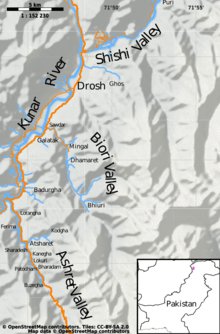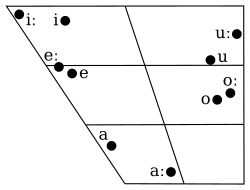Palula language
Palula (also spelt Phalura, Palola, Phalulo) and also known as Ashreti (Aćharêtâʹ) or Dangarikwar (the name used by Khowar speakers), is a Dardic language spoken by approximately 10,000 people in the valleys of Ashret and Biori, as well as in the village of Puri (also Purigal) in the Shishi valley and at least by a portion of the population in the village Kalkatak, in the Chitral District of Khyber Pakhtunkhwa province of Pakistan. It is closely related to the Sawi language of Afghanistan and to Kalkoti, which is spoken in Dir District. The area where Palula is spoken includes 35°28′N 71°53′E.
| Palula | |
|---|---|
| پالولہ | |
| Pronunciation | /paːluːláː/ |
Native speakers | 10,000 (2008)[1] The population of Ashret and Biori Valleys is almost completely monolingual (2008)[1] |
Indo-European
| |
| Palula alphabet (Nastaʿlīq script), see other less-used writing systems below | |
| Official status | |
Official language in | No official status |
| Language codes | |
| ISO 639-3 | phl |
| Glottolog | phal1254[2] |

In some of the smaller villages, Palula has either ceased to be spoken (in the village Ghos, situated near Drosh) or its speakers are largely shifting (as in Puri and Kalkatak) to the more widely spoken Khowar language. However, in the main Palula settlements in the Biori and Ashret valleys, it is a strong, vibrant and growing language, as the population in those areas increases and it is still with a few exceptions the mother tongue of almost all people.
Palula is pronounced as /paːluːláː/, with three long vowels and a rising pitch on the final syllable.
Study and classification
The Palula language has been documented by George Morgenstierne (1926, 1941), Kendall Decker (1992), Henrik Liljegren (2008, 2009, 2010), and Henrik Liljegren & Naseem Haider (2009, 2011).
It is classified as a Dardic language, but this is more of a geographical classification than a linguistic one.
Phonology
Vowels

The following table sets out the vowels of Palula.[3][4]
| Front | Central | Back | |
|---|---|---|---|
| Close | i iː | u uː | |
| Mid | e eː | o oː | |
| Open | a aː |
Nasalization is found; however, it typically limited to vowels preceding sibilants and nasals and word finally.
Consonants
The consonant inventory of Palula is shown in the chart below.[5] The phonemic status of the voiceless aspirate and breathy voiced series are debatable. The breathy voiced series is generally considered lexical—a cluster of a consonant + /h/.[4][6] Neither voiceless aspiration nor breathy voicing co-occur with /s ʂ ʃ ɳ ɽ/ or /x ɣ (f?)/ in a syllable onset.[7]
| Labial | Coronal | Retroflex | Palatal | Velar | Uvular | Glottal | ||
|---|---|---|---|---|---|---|---|---|
| Nasal | voiced | m | n | ɳ | ||||
| breathy voiced | mʱ | nʱ | ||||||
| Stop | voiceless | p | t | ʈ | k | (q [x]) | ||
| voiced | b | d | ɖ | ɡ | ||||
| aspirated | pʰ | tʰ | ʈʰ | kʰ | ||||
| breathy voiced | bʱ | dʱ | ɖʱ | ɡʱ | ||||
| Affricate | plain | ts | tʂ | tʃ | ||||
| aspirated | tsʰ | tʂʰ | tʃʰ | |||||
| Fricative | voiceless | f | s | ʂ | ʃ | x | h | |
| voiced | z | ʐ | ʒ | ɣ | ||||
| Lateral | voiced | l | ||||||
| breathy voiced | lʱ | |||||||
| Rhotic | voiced | r | ɽ | |||||
| breathy voiced | rʱ | |||||||
| Semivowel | voiced | j | w | |||||
| breathy voiced | jʱ | wʱ | ||||||
Tone
Like many Dardic languages, Palula shows either tone or, as in Palula, a pitch accent.[8] Words may have only one accented mora, which is associated with high pitch; the remaining mora have a default or low pitch.[9]
Status
In 2004, Anjuman-e-taraqqi-e-Palula, the Society for the promotion of Palula, was founded by people in the Palula community to promote the continued use of their language and to encourage research and documentation of their language, history and culture. After the establishment of a written form of the language, the society is now engaged in producing literature and educational material in Palula. In 2006, Palula Alifbe (Palula alphabet book) and Palula Shiluka (Palula stories) were jointly published by the Anjuman-e-taraqqi-e-Palula and the Frontier Language Institute in Peshawar.
In 2008, a mother-tongue based educational programme was launched by a local school management committee in Ashret and a first batch of Palula children could start learning to read and write in their own language. Since 2010, two schools operate within this programme in Ashret, using a curriculum developed by the community itself with assistance from the Forum for Language Initiatives (a regional language resource centre based in Islamabad).
References
- Palula at Ethnologue (18th ed., 2015)
- Hammarström, Harald; Forkel, Robert; Haspelmath, Martin, eds. (2017). "Palula". Glottolog 3.0. Jena, Germany: Max Planck Institute for the Science of Human History.
- Liljegren (2008), p. 64.
- Edelman (1983), p. 263.
- Liljegren (2008), p. 58.
- Liljegren (2008), p. 71.
- Liljegren (2008), p. 72.
- Baart (2003), pp. 3, 6.
- Liljegren (2008), p. 74–76.
Bibliography
- Baart, Joan L. G. (2003), Tonal features in languages of northern Pakistan (PDF), National Institute of Pakistan Studies, Quaid-i-Azam University and Summer Institute of Linguistics, pp. 3, 6
- Decker, Kendall D. (1992) Languages of Chitral ISBN 969-8023-15-1 http://www.ethnologue.com/show_work.asp?id=32850
- Edelman, D. I. (1983), The Dardic and Nuristani Languages, Moscow: Institut vostokovedeniia (Akademiia nauk SSSR)
- Haider, Naseem. 2012. Palula matali. [Palula proverbs]. (Maqami Zaban-o-Adab kaa Ishaati Silsila 1.) Islamabad: Forum of Language Initiatives
- Liljegren, Henrik (2008). Towards a grammatical description of Palula: An Indo-Aryan language of the Hindu Kush (PhD dissertation thesis). Stockholm: Stockholm University. ISBN 978-91-7155-599-1. urn:nbn:se:su:diva-7511.CS1 maint: ref=harv (link)
- Liljegren, Henrik (2009). "The Dangari Tongue of Choke and Machoke: Tracing the proto-language of Shina enclaves in the Hindu Kush". Acta Orientalia. 70: 7–62.
- Liljegren, Henrik (2010). "Where have all the verbs gone? On verb stretching and semi-words in Indo-Aryan Palula" (PDF). Himalayan Linguistics. 9 (1): 51–79. doi:10.5070/H99123044. Archived from the original (PDF) on 2012-03-15.
- Liljegren, Henrik; Haider, Naseem (2009), "Palula", Journal of the International Phonetic Association, 39 (3): 381–386, doi:10.1017/S0025100309990193
- Liljegren, Henrik; Haider, Naseem (2011). Palula Vocabulary. FLI Language and Culture Series, No. 7. Islamabad: Forum for Language Initiatives. ISBN 978-969-9437-07-6. urn:nbn:se:su:diva-65210.
- Liljegren, Henrik (2016). A Grammar of Palula. Studies in Diversity Linguistics 8. Berlin: Language Science Press. doi:10.17169/langsci.b82.85.
- Morgenstierne, Georg (1926) Report on a Linguistic Mission to Afghanistan. Instituttet for Sammenlignende Kulturforskning, Serie C I-2. Oslo. ISBN 0-923891-09-9
- Morgenstierne, Georg (1941). Notes on Phalura: An unknown Dardic language of Chitral (PDF). Oslo: J. Dybwad.
- Strand, Richard F. (2001) The tongues of Peristân. Appendix 1, pp 251–257 in Gates of Peristan: History, Religion and Society in the Hindu Kush, Reports and memoirs, edited by Alberto M Cacopardo and Augusto S Cacopardo. Rome: IsIAO.
- The Languages Of Pakistan, Badshah Munir Bukhari. London
External links
| Palula language test of Wikipedia at Wikimedia Incubator |
- Phalula Community Welfare Organization, contains various materials in and about the language
- Liljegren PhD dissertation full text
- Palula research (Henrik Liljegren)
- Palulaforskning (in Swedish)
- Palula phonology
- Palula morphology
- Palula sample text
- Anjuman-e-taraqqi-e-Palula
- Georg Morgenstierne multimedia database
- Strand, Richard F. (1998). "An Account of Aćhar'îta History in Aćharêtâ'". Retrieved 2012-01-16.
- Strand, Richard F. (1998). "Genealogy of the Aćhar'îta". Retrieved 2012-01-16.
- Strand, Richard F. (2000). "Aćharêtâʹ Lexicon". Retrieved 2012-01-16.
- Strand, Richard F. (2000). "The Sound System of Aćharêtâʹ". Retrieved 2012-01-16.
- Strand, Richard F. (2000). "The Cognitive Geometry of Object Relationships: Case Markers and Subject Reference [in Aćharêtâʹ]". Retrieved 2012-01-16.
- Henrik Liljegren. (2019). dictionaria/palula: Palula Dictionary (Version v1.0) [Data set]. Zenodo. doi:10.5281/zenodo.3066952